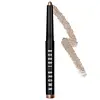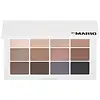Bobbi Brown Long-Wear Cream Shadow Stick Versus Makeup by Mario Master Mattes Eyeshadow Palette The Neutrals
What's inside
What's inside
 Key Ingredients
Key Ingredients

 Benefits
Benefits

 Concerns
Concerns

 Ingredients Side-by-side
Ingredients Side-by-side

Methyl Trimethicone
Skin ConditioningTrimethylsiloxysilicate
EmollientSynthetic Wax
AbrasiveLauroyl Lysine
Skin ConditioningPolymethylsilsesquioxane
Stearoxymethicone/Dimethicone Copolymer
EmollientOctyldodecanol
EmollientSilica
AbrasiveSynthetic Fluorphlogopite
Caprylic/Capric Triglyceride
MaskingPolyglyceryl-3 Polyricinoleate
EmulsifyingCopernicia Cerifera Wax
Polyhydroxystearic Acid
EmulsifyingPolyethylene
AbrasiveMicrocrystalline Wax
Emulsion StabilisingIsostearic Acid
CleansingDicalcium Phosphate
AbrasiveLecithin
EmollientDisteardimonium Hectorite
StabilisingPropylene Carbonate
SolventCalcium Aluminum Borosilicate
Calcium Sodium Borosilicate
Tin Oxide
AbrasivePentaerythrityl Tetra-Di-T-Butyl Hydroxyhydrocinnamate
AntioxidantMica
Cosmetic ColorantCI 77891
Cosmetic ColorantCI 77491
Cosmetic ColorantCI 77492
Cosmetic ColorantCI 77499
Cosmetic ColorantCI 77007
Cosmetic ColorantCI 42090
Cosmetic ColorantCI 77288
Cosmetic ColorantCI 77289
Cosmetic ColorantCI 19140
Cosmetic ColorantCI 77510
Cosmetic ColorantCI 75470
Cosmetic ColorantCI 77400
Cosmetic ColorantCI 77163
Cosmetic ColorantCI 77000
Cosmetic ColorantCI 77742
Cosmetic ColorantMethyl Trimethicone, Trimethylsiloxysilicate, Synthetic Wax, Lauroyl Lysine, Polymethylsilsesquioxane, Stearoxymethicone/Dimethicone Copolymer, Octyldodecanol, Silica, Synthetic Fluorphlogopite, Caprylic/Capric Triglyceride, Polyglyceryl-3 Polyricinoleate, Copernicia Cerifera Wax, Polyhydroxystearic Acid, Polyethylene, Microcrystalline Wax, Isostearic Acid, Dicalcium Phosphate, Lecithin, Disteardimonium Hectorite, Propylene Carbonate, Calcium Aluminum Borosilicate, Calcium Sodium Borosilicate, Tin Oxide, Pentaerythrityl Tetra-Di-T-Butyl Hydroxyhydrocinnamate, Mica, CI 77891, CI 77491, CI 77492, CI 77499, CI 77007, CI 42090, CI 77288, CI 77289, CI 19140, CI 77510, CI 75470, CI 77400, CI 77163, CI 77000, CI 77742
Talc
AbrasiveZinc Stearate
Cosmetic ColorantHdi/Trimethylol Hexyllactone Crosspolymer
Triethoxycaprylylsilane
Caprylic/Capric Triglyceride
MaskingDimethicone
EmollientCaprylyl Glycol
EmollientEthylhexylglycerin
Skin ConditioningAlumina
AbrasiveGlycerin
HumectantSilica
AbrasiveTocopherol
AntioxidantCI 77891
Cosmetic ColorantIron Oxides
CI 77163
Cosmetic ColorantCI 77742
Cosmetic ColorantCI 19140
Cosmetic ColorantKaolin
AbrasiveCI 75470
Cosmetic ColorantCI 77007
Cosmetic ColorantCI 77499
Cosmetic ColorantCI 77266
Cosmetic ColorantTalc, Zinc Stearate, Hdi/Trimethylol Hexyllactone Crosspolymer, Triethoxycaprylylsilane, Caprylic/Capric Triglyceride, Dimethicone, Caprylyl Glycol, Ethylhexylglycerin, Alumina, Glycerin, Silica, Tocopherol, CI 77891, Iron Oxides, CI 77163, CI 77742, CI 19140, Kaolin, CI 75470, CI 77007, CI 77499, CI 77266
Ingredients Explained
These ingredients are found in both products.
Ingredients higher up in an ingredient list are typically present in a larger amount.
This ingredient is an emollient, solvent, and texture enhancer. It is considered a skin-softener by helping the skin prevent moisture loss.
It helps thicken a product's formula and makes it easier to spread by dissolving clumping compounds.
Caprylic Triglyceride is made by combining glycerin with coconut oil, forming a clear liquid.
While there is an assumption Caprylic Triglyceride can clog pores due to it being derived from coconut oil, there is no research supporting this.
Learn more about Caprylic/Capric TriglycerideCI 19140 is also known as Tartrazine. Tartrazine is a synthetic dye used in cosmetics, foods, and medicine to add a yellow color.
Tartrazine is created from petroleum and is water-soluble.
Some people may experience allergies from this dye, especially asthmatics and those with an aspirin intolerance.
Learn more about CI 19140Ci 75470 is a bright-red pigment. It is AKA carmine.
Carmine is derived from insects such as the cochineal beetle. This ingredient has been used as a natural dye for over 2000 years.
This pigment is called Ultramarine blue lazurite. It gives a saturated blue color, but can be used to create other colors as well.
According to the manufacturer, it is usually made from kaolin, sodium sulfate, sodium carbonate, sulfur, and charcoal.
This synthetic powder is used to add a pearly/white color in cosmetics.
Ci 77499 is also hydrated iron III oxide. It is created from mixing red and black iron oxides. This helps give shades of darkness to a product.
Iron III oxides are classified as inorganic chemicals for coloring.
This ingredient is used to add a violet color to cosmetics.
It is created by reacting phosphoric acid, ammonium dihydrogen orthophosphate, and manganese dioxide.
Ci 77891 is a white pigment from Titanium dioxide. It is naturally found in minerals such as rutile and ilmenite.
It's main function is to add a white color to cosmetics. It can also be mixed with other colors to create different shades.
Ci 77891 is commonly found in sunscreens due to its ability to block UV rays.
Learn more about CI 77891Silica, also known as silicon dioxide, is a naturally occurring mineral. It is used as a fine, spherical, and porous powder in cosmetics.
Though it has exfoliant properties, the function of silica varies depending on the product.
The unique structure of silica enhances the spreadability and adds smoothness, making it a great texture enhancer.
It is also used as an active carrier, emulsifier, and mattifier due to its ability to absorb excess oil.
In some products, tiny microneedles called spicules are made from silica or hydrolyzed sponge. When you rub them in, they lightly polish away dead skin layers and enhance the penetration of active ingredients.
Learn more about Silica